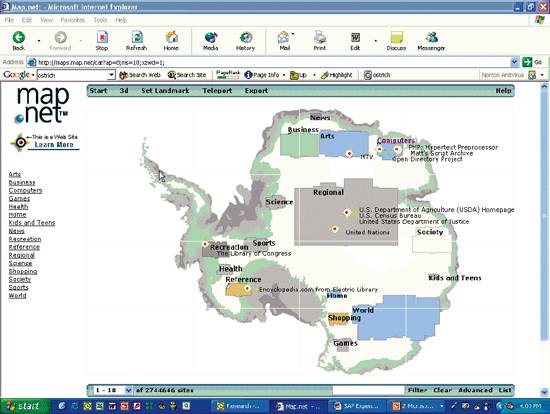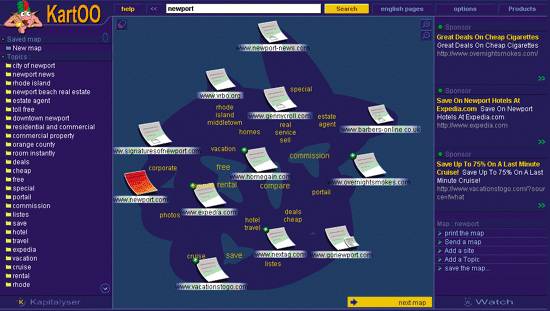Section 2.6. The Web
2.6. The WebThe principles of wayfinding are clearly relevant in immersive virtual environments, from video games to architectural walkthroughs to battlefield simulations. But do they apply to the everyday Web? Does our knowledge of orientation and navigation in the physical world have value in the digital worlds of web sites and intranets? We've certainly created a multitude of spatial metaphors to explain the Web, from Al Gore's information superhighway to the proliferation of home pages, site maps, and breadcrumbs. And web designers have aggressively embraced metaphor by creating information architectures, blueprints, and navigation systems. And yet, some researchers have begun to question the usefulness of these metaphors. Andrew Dillon and Misha Vaughan assert that "navigation is a limited metaphor for hypermedia and website use that potentially constrains our understanding of human-computer interaction." They argue that unlike physical navigation where the destination is the goal, in semantic spaces, the journey is the destination. They suggest, as an alternative, the concept of information shape and the harnessing of perceptual cues embedded in genre. As we'll discuss later, there is real potential in these ideas. The exploration of new metaphors and the courage to design beyond metaphor are both critical to innovation in web design. However, the positioning of shape and genre as replacing rather than complementing the navigation metaphor is a mistake. All metaphors have limits. All metaphors can be taken too far. But that does not negate their core value. There is no question that people experience the Web as a type of space in which they move. A paper called "Metaphors We Surf the Web By" presents detailed evidence that web users remember and talk about the Web in terms of spatial navigation.[*] We use a mix of trajectory metaphors (e.g., "I went to the IBM home page") and container metaphors (e.g., "I found that inside Yahoo!"). We construct cognitive maps. We remember (and bookmark) landmarks and anchor points. We traverse paths or clickstreams in search of information objects. And we often become lost and disoriented.
On the other hand, attempts to map the Web using information visualization techniques mostly fail. Over the past decade, there have been a number of well-financed efforts to solve search and navigation problems with interactive maps. These companies and their products, shown in Figures 2-13 to 2-15, enjoy tons of media coverage because their pretty pictures and futuristic visions attract attention. They are held up as a revolutionary step forward in human-computer interaction. They are the Next Big Thing. And then they disappear. These spatial visualization approaches fail because there's no there there. As David Weinberger explains, "The Web is a public place completely devoid of space.... We can move from place to place but without having to traverse distance."[
|
EAN: 2147483647
Pages: 87
 ] There are billions of web sites, and theyre all a single click from each other. We do experience movement through sites. We can even rely on egocentric dead-reckoning techniques for wayfinding by recalling, for instance, that it was two clicks deep into the product taxonomy before the whitepaper link appeared. But that distance is not real. There's always a shortcut. There's always another route. A keyword search sorts through four billion pages in a quarter second. Google requires no metaphor. Just results. Text and hypertext. Fast. While the Web celebrates hypermedia, it is first and foremost a textual medium for communication and information sharing. Our experience of the Web depends upon the use of words to convey
] There are billions of web sites, and theyre all a single click from each other. We do experience movement through sites. We can even rely on egocentric dead-reckoning techniques for wayfinding by recalling, for instance, that it was two clicks deep into the product taxonomy before the whitepaper link appeared. But that distance is not real. There's always a shortcut. There's always another route. A keyword search sorts through four billion pages in a quarter second. Google requires no metaphor. Just results. Text and hypertext. Fast. While the Web celebrates hypermedia, it is first and foremost a textual medium for communication and information sharing. Our experience of the Web depends upon the use of words to convey

